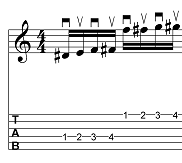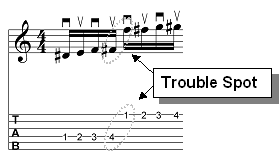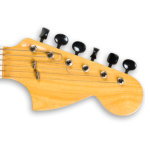Have you ever been working on a guitar song and get to a part where your pick-hand stumbles a bit?
Frequently the cause of this pick-hand stumble is because your pick-hand has to jump over two or more strings to play the next note. This is called string skipping.
In this tutorial we look at the guitar technique string skipping. You’ll learn what it is, how to perform it and you’ll learn some guitar technique exercises to help you master it.
String skipping simply means that you are playing notes on one string and then skip over one or more strings to play the next note. String skipping can be quite tricky at times. So let’s look at some exercises you can work on to master it.
Be sure to practice each exercise slowly and make sure you produce clear notes.
Generally you will find alternate picking to be the most efficient way to play passages on non-consecutive strings. But this rule is not set in stone. Sometimes it will make more sense to use sweep picking. Context should be the ultimate judge.
String Skipping Exercise # 1
This exercise skips over one string and should be played ascending to the 12th fret and then backwards to the first fret. The exercise is shown for strings 3—1, but should also be practiced with the following string groupings: 4—2; 5—3; and 6—4.
String Skipping Exercise # 2
This exercise skips over 2 strings and like exercise 1 it should be played up to the 12th fret and then played backwards to the first fret. The exercise is shown for strings 4—1, but should also be practiced with the following string groupings: 5—2, and 6—3.
The above two exercises just used the finger combination 1-2-3-4. You can also do string skipping exercises with different finger combinations. For example, 1-2-4-3, 1-3-2-4, 1-3-4-2, 1-4-2-3 and 1-4-3-2, etc. can all be used with string skipping.
Performance Tip
To finish off this tutorial, I want to leave you with a tip.
When you encounter an area in a song where you frequently make errors, you should aim to isolate and eliminate the trouble spot.
Let’s say that you are having trouble with the string skip from the fourth string to the first string in the example shown below.
What do you do?
You isolate and eliminate.
You look closer and discover the actual trouble spot in the passage:
So what you do is focus on just the trouble spot. In other words, ignore everything else and just focus on the notes on the fourth string and the first string.
Practice these two notes:
Once you feel comfortable with this, expand out by adding in one note before the string skip.
Practice this until you’ve got it down. Then add in the next note after the string skip.
Now focus on this passage until you’ve got it down.
Next, simply repeat this process until you’ve added in the notes in the phrase before and after your string skip and bingo─you’ll have that string skip nailed down!
Are you interested in some powerful string skipping chop-building exercises? Check out Mega Chops: Scale Mastery Beyond Hanon.
String Skipping Exercise # 2
This exercise skips over 2 strings and like exercise 1 it should be played up to the 12th fret and then played backwards to the first fret.The exercise is shown for strings 4—1, but should also be practiced with the following string groupings: 5—2, and 6—3.

















You actually spoke about many engaging points here. I found it by searching Yahoo and I must admit that I am currently subscribed for your blog, it is extremely decent